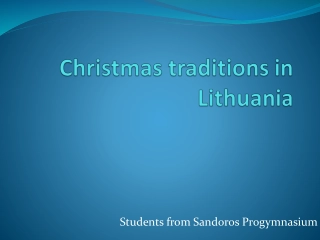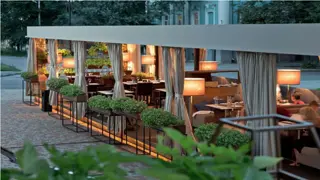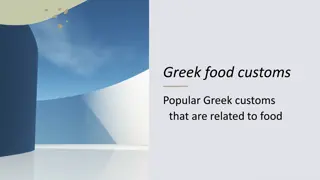Greek Christmas Traditions: Christopsomo, Kallikantzaroi, and Kalanta
Explore the rich Christmas traditions of Greece, from the festive Christopsomo bread to the mischievous goblins known as Kallikantzaroi, and the joy of Kalanta caroling by children going door to door. Experience the unique rituals and folklore that make Greek Christmas celebrations truly special.
Download Presentation

Please find below an Image/Link to download the presentation.
The content on the website is provided AS IS for your information and personal use only. It may not be sold, licensed, or shared on other websites without obtaining consent from the author.If you encounter any issues during the download, it is possible that the publisher has removed the file from their server.
You are allowed to download the files provided on this website for personal or commercial use, subject to the condition that they are used lawfully. All files are the property of their respective owners.
The content on the website is provided AS IS for your information and personal use only. It may not be sold, licensed, or shared on other websites without obtaining consent from the author.
E N D
Presentation Transcript
NIPIAGOGEIO DREPANOU CHRISTMAS IN GREECE CHRISTMAS IN GREECE
Christopsomo, which translates as Christs Bread- (Christopsomo (bread of Christ) graces the Christmas table. Christ Bread was once the centerpiece of traditional Greek Christmas tables, as were large quantities of dried figs, nuts and honey. Traditionally on Christmas Eve every household would bake a Christopsomo or Christ bread . It is always decorated with a cross and other patterns. Baked with the highest quality ingredients
KALLIKANTZAROI THE GOBLINS The goblins are demonic beings that according to the Greek folk perception come to earth and disturb people at nights, during the Twelveday, from Christmas Eve until Epiphany. According to folk belief these days the water is not baptized and goblins come out of the earth to tease people now that Christ is also not baptized. They are blackish, hairy, with a tail and long arms and they have given them various names and characteristics. Goblins live in the bowels of the earth and with a large saw they are struggling to cut the huge Tree that holds in place the whole earth. But the tree is very thick and therefore requires a large and long-term effort. They come to the surface near the end of their work, As they fear that the crumbling earth will crush themA.
KALLIKANTZAROI THE GOBLINS As they are small and agile, they enter the houses from whereever they find: from the chimneys, keyholes, the cracks of the doors and windows. As soon as they enter the houses they mess with the kitchen, grab the clothes, steal Christmas sweets, scatter the flour or ash from the fireplace. It is generally believed that goblins are unable to hurt people but they can only hurt, annoy or frighten them. The goblins disappear the day of Epiphany when the priests throw the cross into the sees and rivers and bless the waters. They leave the surface of earth saying: Flee, Flee And here comes the crazy priest With his basil and his holy water He sanctified us, he rained us And he entirely burned us!
KALANTA - CAROLS Like many parts of the world, there is a tradition in Greece of going door to door to sing Christmas carols.This is primarily done in Greece by children, who are often invited into people s homes for a snack after they are done singing. When they are done with their visit, they move on to the next house. A carol is also known as Kalanda or Kalanta in Greek. These carols play an important part in Greek Christmas tradition and they are typically sung on both New Year s Eve and Epiphany Eve. Children go door to door singing, often carrying triangles and other instruments,to accompany the songs. They ask, Na ta poume? Translated in English this means, Shall we say it? or Shall we sing? The answer, of course, is yes. Once you agree to let them sing, they begin. Once the song is over, they are usually invited in where they are given a small gift or money or asked to enjoy some refreshment with the family, such as some cookies.
KARAVAKIA GREEK TRADITIONAL CHRISTMAS BOATS The decoration of the Christmas tree is not a Greek habit. According to the tradition, we decorate a boat, mainly on the islands. The boat symbolizes the maritime identity of the country. Greeks, a seafaring nation, of course, combined the celebration of Christmas with the sea. The decoration of the ship was also a kind of honor and welcome to the sailors returning home to celebrate Christmas with their families. Children used to make their own boat, using wood and paper and then decorate them with colorful fabrics, cotton and twigs.























